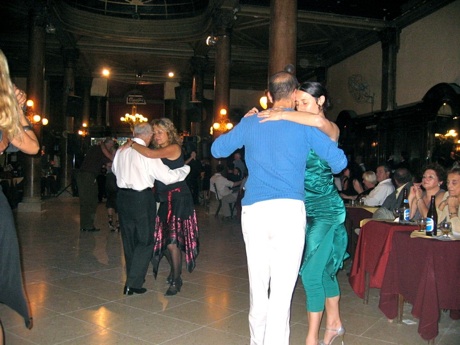Dancing Tango in Buenos Aires and the Alexander Technique
by Sabine Heubusch
Next to New York City, Buenos Aires had the largest immigration boom in the late 18th and early 19th century. By 1920, Argentina grew from a small settlement to one of the richest nations in the world. Tango was an important expression of Argentine culture until 1950 when Argentina underwent a military regime and Tango was replaced by Rock and Roll. The fall of the military junta in 1983 saw Tango make a come back up which has continued to the present time. Despite having undergone massive economical crises in 2001, Buenos Aires is still a functioning, elegant and charming cosmopolitan city with strong ties to both its tradition as well as modern influences.
The Origin of Tango is not well documented, because it was the poor and the working class people that created Tango in the mid 19th century. Dancing in the port and in prostitution places was a way to compensate for the misery of long labor.
Tango has elements of European dances such as flamenco, polka, and waltz as well as Cuban and African rhythms. Tango was the 1st ballroom dance that was improvised. Argentina Tango exists of 3 dances: Tango, Waltz, and Milonga.

I had no idea how complex Tango is, and how much it requires: walking technique, step combinations, embellishments, balance, strength, and, most importantly, the skill to improvise/to be able to respond to a partner and the music. The man decides how to put the steps together- which is the skill of improvisation- and the woman follows, but cannot anticipate the movement until he initiates. A good leader brings pauses into the dance, these are the moments of stillness. When I was a beginner, most men would tell me to wait, as I was eager to figure out what to do next, making sure I would be a good follower. I noticed how I started to hold by breath and built up tension in my torso and elbows. By seeing what I did, I was later able to use the pauses as an opportunity to renew the flow of energy, breath, and connection. The difference of knowing and living with the Alexander Technique is that patterns of compensations come into my awareness more quickly and I can use my kinesthetic intelligence to remember the patterns, using inhibition not to do them over and over again. One of my 1st teachers, of the older generation, taught me that I should never allow a man to squeeze my hand, and if he does so, that I should gently move my hand out of his grip. Mostly men seem to be open for the feed back, though a few minutes later, the grip comes back, which can be quiet painful for the hand and wrist. And there is a choice a woman has, which I learned later, (believing that the men only can end the dance), after only one dance, she can smile and say “Thank you.” In the beginning I was eager to learn embellishments, but no teacher would teach them to me. The answer was ”As you get more relaxed they will come by themselves.” Some other teachers taught me not to worry which steps to do, and encouraged me to make the floor as my friend and just let my feet walk and glide along. Other corrections I received were to be upright and let the shoulders to be open, to move my back into the leaders hand, to keep my arms free….These are all concepts of the Alexander Technique, hearing them immediately gave me the ability to relate to the corrections, knowing what to do/knowing how to undo and reminding myself that learning is about expanded awareness and trusting that the right thing will happen by itself.
All subjects I am teaching do help me to dance Tango: Eurhythmics and piano for the musicality, Pilates for the abdominal strength, dance for the embellishments, and yoga for the peace of mind. The Alexander Technique though makes it all come together, and helps me continuously discover all these subjects in a new light. It gives me the freedom to choose and to experience being in the moment, connecting to all my different partners by staying at ease even if someone is tense, being willing not to know what’s next and most of all b e i n g the dance.
The last few nights dancing in Buenos Aires became such a pleasure. My brain relaxed as my legs did all the work and were surprising me with steps I had seen, but never done before. I had my eyes closed most of the time, feeling the unity of two dancing bodies while the music was resonating in my entire body.
Sabine Heubusch is an ACAT/AmSAT certified Alexander teacher, certified Dalcroze Eurhythmics teacher, certified Yoga, and Pilates Mat teacher
